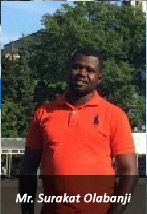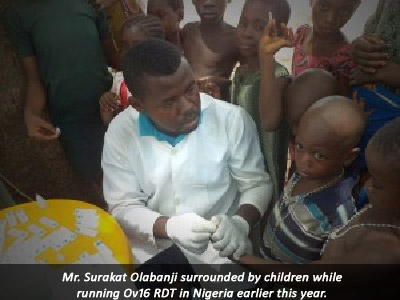
A postgraduate student, who is currently undergoing a Doctorate degree in Parasitology in the University, Mr. Olabanji Surakat, is rising high courtesy of the Programme for Appropriate Technology in Health (PATH), based in Seattle, United States of America, for his immense contributions to the alleviation of Onchocerciasis, a disease commonly known as River Blindness. PATH has offered Olabanji, an opportunity to work with the team in its Seattle laboratory to learn the Enzyme-linked Immunosorbent Assay (ELISA) Testing Techniques and compare the Ov16 RDT results against the PATH Ov16 ELISA.

Olabanji, who studied Zoology for his First Degree and has a Master’s Degree in Parasitology from FUNAAB, had collected skin-snip samples in early 2015 from people in communities and who had been tested for baseline levels of Onchocerciasis about ten years ago. The goal was to evaluate the impact of ten years of mass administration of the drug, Ivermectin. In addition to the skin-snip samples and nodule palpation, Olabanji used the SD BIOLINE Onchocerciasis IgG4 Rapid Test (Ov16RDT) while PATH helped develop the test, which indicates previous exposure to the disease-causing parasite by testing for antibodies to the Ov16 antigen.
The Doctorate student said he first learnt of Onchocerciasis, one of the neglected tropical diseases that the World Health Organisation (WHO) was targeting to eliminate under the Millennium Development Goals (MDGs) initiative, as a youngster. Describing how he developed interest in the study, he said even though he knew of the disease as a kid, the determination to embark on the study grew from his tutor, who eventually became his mentor and supervisor, Professor Sammy Sam-Wobo, while working on a WHO project on Blackfly Migration between Nigeria and Benin Republic. It was Professor Sam-Wobo who later offered a mentorship opportunity to work with him. The Blackfly vector is responsible for the transmission of the disease-causing parasite, Onchocerca volvulus.
“I volunteered and that was my first field experience. I grew up in Lagos, and for the first time, I got to see people in a rural environment, I got to see how it feels living in villages. The samples I brought to PATH were from a study conducted in 32 Nigerian communities, spread across the eight districts that had been marked meso-endemic for Onchocerciasis in Ogun State. The project lasted about three-and-a-half months. I had the support of the Ministry of Health of Ogun State and the Onchocerciasis coordinators of each district in addition to many nurses, students, and other team members”, he stated.

Comparing the Ov16 test with the skin-snip, Olabanji said the Ov16 test is a culturally-acceptable test while the skin-snip is not, stressing that women, most especially, can relate to the Ov16 test because they do a similar process for pregnancy tests. His words: “People are excited about the 20 minutes read-time, to see their results, and they are willing to hang around. Friends and family come out, instead of running away from the test. On one occasion, a guy was so impressed with the test and the drug that he got on his motorbike and called his family and friends to come take the test. With the skin-snip, if 200 people needed to be tested, only nine will agree and by the time you do the first one, no one else wants to do it”.

He, however, declared that the process of collecting and examining skin-snip samples and running the Ov16 RDT was a social affair. Olabanji added that he had looked forward to getting a fellowship opportunity, while PATH had made the dream come true for him. He noted that he embraced the training on techniques he read in books, adding that he had hands-on experience learning how to run them which had given him insights into the possibility of going back and making use of the University’s laboratories.
“In my University, we have some of these similar tools in the Central Biotechnology Laboratory for general use. I look forward to incorporating these new techniques in future studies. It’s a whole lot of new thoughts in terms of research and what we could achieve. I look forward to strengthening the capacity I’ve been able to build here. I want to do more. I want to learn more. I just see that there is so much to learn here”, he disclosed. Reacting to the challenges facing his research and in the elimination of Onchocerciasis from Nigeria, the FUNAAB researcher said, it would require good funding, saying that “we are ready to do a lot of research in Nigeria, if the environment is made favourable. We are also looking forward to having collaborations with organisations like PATH and others”.
Last Updated on November 28, 2015 by admin
